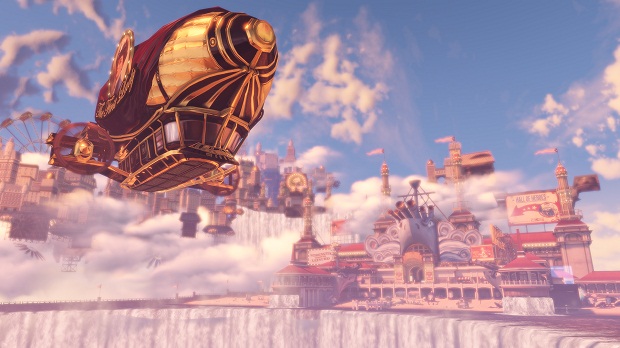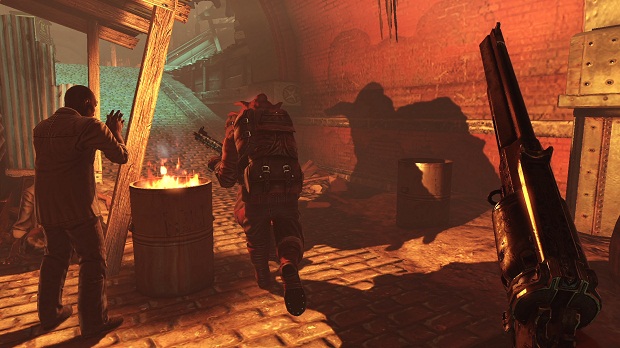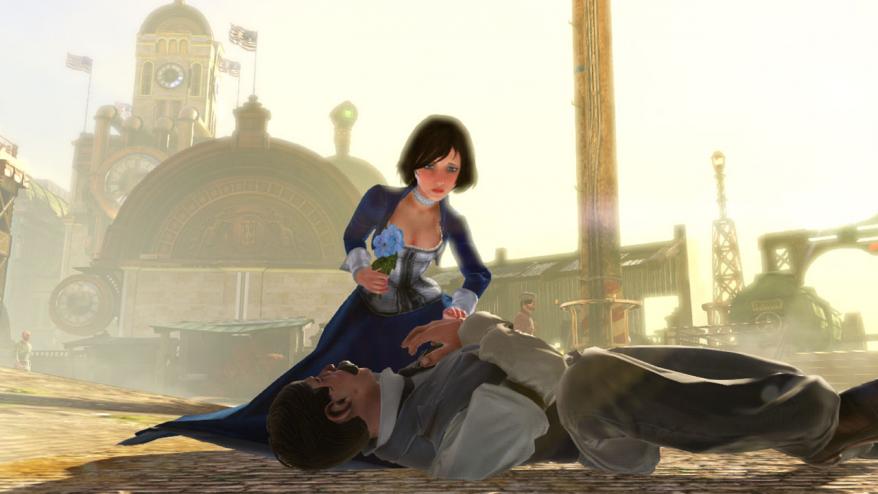Your login information returned multiple users. Please select the user you would like to log in as and re-type in your password.

Every generation that has come along there have been those few memorable titles that, beyond being great experiences, really makes the player put down the controller and truly consider their actions and the implications of the story. 2007’s release of Bioshock by then 2K Boston and meant to be a spiritual successor to the beloved System Shock series, stands as one of those few. Your journey to the decimated city of Rapture at the bottom of the Atlantic was a roller coaster ride of self-discovery whose plot twist is easily one of the most talked about moments in video games since the dawn of achievements. 2K Marin would go on to make a sequel to the adventure under the sea but the newly redubbed Irrational Games had, dare I say, loftier plans for the franchise.
You’ve heard us talk a LOT about Infinite on the site but it’s time to give the game a final review. So here’s the question: does Bioshock Infinite rise to the occasion? Here’s what I think.
Bioshock Infinite
Developer: Irrational Games
Publisher: 2K Games
Release Date: March 26th, 2013 (360, PS3, PC)

Another Ark, For Another Time
At the 1893 World’s Fair one of the many inventions and concepts shown off was the floating city of Columbia, a tribute to the new idea of American exceptionalism. Built by Zachary Comstock, the United States government commissioned Columbia to travel throughout the world to demonstrate the rising power that America was becoming. But then something happened: during a routine trip to China an anti-imperialist movement attacked, taking American hostages. The event, known today as the Boxer Rebellion, saw Columbia fire upon the Chinese in retaliation, an act in defiance of Washington’s orders that resulted in the deaths of hundreds. Columbia then seceded from the Union and disappeared into the heavens.
Nineteen years after the Boxer Rebellion, former Pinkerton agent and private detective Booker DeWitt, an experienced combat veteran of the Battle of Wounded Knee, is approached by a man who is willing to solve Booker’s gambling problems. Booker’s task: infiltrate the city of Columbia, retrieve a girl named Elizabeth and bring her safely back to New York. Our story begins on a stormy night at a lighthouse off the coast of Maine and from here, Booker is on his own.
The story of Bioshock Infinite, in many ways, is both a continuation and an evolution of the Bioshock formula put forth in the previous two games. The evolution specifically comes in the form of the principle characters of Booker DeWitt and Elizabeth in comparison to yesteryear’s composition of Andrew Ryan, Brigid Tenanbaum and Frank Fontaine who saw very limited appearances, not to mention Jack who never spoke and who’s moral fortitude was determined by the rescue or harvesting of Little Sisters. The continuation of the formula comes in the form of the city of Columbia and the way the background events occur but before we get to that, let’s begin by looking at our protagonists.
To start, let’s take a look at Booker. Irrational Games, unlike what was done for the first two games, decided to give the main character a voice this time around. A game played for the first person perspective rarely gives a voice to the main character save for in cutscenes wherein the camera pans to show the character you’re playing as and, for that, I’m grateful to the developer for trying this. First person games don’t need to force the main character to be a silent protagonist and, in my opinion, there is much more room for narrative crafting if you allow the player character to interact vocally with the rest of the world. We need to see more of this in games going forward.
As for Booker’s character specifically I have to say that he is a very interesting one. Just by the way he speaks and the dreams he has throughout the game you immediately get the feeling of a downtrodden, tired man. The choices he has made throughout his life have really worn him down and you can easily gleam that this last chance to clear his debts is also an opportunity to make up for the wrongs he’s done in his life. Booker is clearly a very well done character and his ‘man on a mission’ mantra begins to change in a far more attention-drawing way once we are introduced to Elizabeth.
Elizabeth, without a doubt, is easily one of the best parts of Bioshock Infinite. Though she has been locked away in a tower all her life, Elizabeth is anything but a damsel in distress. She’s very intelligent, remarkably introspective and, beyond almost every other aspect, a wonderfully innocent person. The first half hour of your time with Elizabeth is simply adorable as she gets to experience world outside of her cage for the first time, enjoying all the marvelous things life has to offer before being shown the cruelty of man and our natural violence as the police and Comstock’s agents attempt to recapture her. Her innocence is simply wonderful and serves as a rather fantastic omega to Booker’s depressed, guilty alpha. Elizabeth’s part in Infinite almost comes across as a coming-of-age tale as she is torn from the innocence of youth in her tower and must grow and adapt to the terrible truths that exist within Columbia. She’s a wonderful character and easily one of the best female protagonists in years.
Though Columbia itself is a wonderful backdrop for the game the similarities between this city in the sky and the fallen underwater utopia make the case for the story being a continuation of Bioshock’s formula in comparison to the character evolution. Whereas Rapture was a caricature of a society built on the progression of science and the abandonment of religious and moral values that held that progress back, Columbia is the philosophic (not to mention physical) polar opposite of Andrew Ryan’s dream: a society built on religion that seeks to stem the growth of science and social progression. Rapture’s downfall came at the hands of a working-class uprising and so too does Columbia’s, albeit that the first game’s revolution occurs well before the player ever gets to the lighthouse and Columbia’s civil war occurs during Booker’s visit. The themes are similar but there’s not enough difference between the two to say that Infinite is truly that different from Bioshock.

Along with the themes comes the way that Irrational chose to tell the story of Infinite. The game’s twist unfortunately comes during the later third of the game so pacing can be a bit of an issue. Much of the backstory is told through Voxophones, audio diaries that are found in exactly the same manner that was seen in Bioshock 1 and 2 so any hope for discovering vital story elements through unrequired NPC interaction and environmental exploration remains unrealized. It’s clear to me at least that Irrational wanted to play things safe with Infinite in these regards and while it would be nice to gleam more from this rather strange and intriguing world through other means, sticking to what works doesn’t harm the story as a whole.
Beyond just the comparisons of running themes and storytelling methods I would be remiss if I didn’t talk about some of the unique story elements that Infinite has a lot to offer. Using the backdrop of the early 20thcentury, a short time before the assassination of Archduke Franz Ferdinand drew Europe into war, Irrational Games gave us a time period in Americana that is rather fantastical to explore. Extreme nationalism is rampant throughout the flying city and feelings of racial purity and racism are commonplace throughout the higher classes. Religion comes in the form of the worship of Comstock as a prophet who leads Colombia to a brighter tomorrow and whose saints come of the form of America’s found fathers such as Washington and Jefferson. The religion and racism tie together in many ways. For example, a group known as the Fraternal Order of the Crow dedicates themselves to the memory of Comstock’s deceased wife and worship John Wilkes Booth for his assassination of Abraham Lincoln behind black cowls very much like those worn by the Ku Klux Klan. All of this is a little bit jarring when you find yourself stepping up to a public stoning of an interracial couple in the middle of a fair but it’s done so in such a way that you find yourself almost in awe of what’s going on as it is such a contrast to today’s values and ethics. It’s incredibly wrong to watch but, in the end, you get to shoot all these racist bastards in the face so, hey, it all works out.
Though I won’t go into any specific spoilers for the game I will say that Irrational put together a rather brilliant yarn. The ending alone makes up for many of the game’s story-related flaws as it leaves you remarkably satisfied and without the need for sequel-baiting. It stands to wonder just what Irrational has planned for the games downloadable content coming later this year, especially given just how we didn’t get to see as well as the content that was lost in transition between the early demonstrations and the final product. But for now, let’s just right into the gameplay.
Leading the Lamb Astray
Like the two Bioshocks before it, Infinite plays as a traditional first person shooter in many respects. As with the previous titles you will find yourself killing enemies, looting bodies and your surrounds and upgrading your weapons as you traverse the streets of Columbia. For the most part, the experience is a slightly more fast-paced version of what we all know and love but with this new iteration comes a few changes as well as additions to this tried-and-true formula.
First up: the player’s weapon selection. As before, you will find a variety of firearms such as pistols, shotguns, machine guns and heavy explosives to deal damage to your foes. What you will take note of however is the game’s limitation of your inventory to two weapons at any given time. This encourages more scrounging in the environment and should, theoretically, force the player to experience all the weapons to be found in the game. The way the game is structured with ammo and weapon placement, however, never stresses the player to switch out your firearms, allowing you to almost always maintain the same pair of weaponry throughout Infinite unless playing on the game’s infamous 1999 mode. There are no alternate ammunition types to be found and weapon upgrades cost money now, allowing you to max out any weapon you want without, again, forcing the player to specialize.
Much like the plasmids of yore, Bioshock Infinite contains various powers the player can accumulate called vigors, powers that are paced throughout the game and are powered by salts. Though they work almost the same way as before, most will come with a secondary fire option automatically such as the ability to lay traps out for enemies to trip over. The variety of vigors to find are paced throughout the game but there are only eight to collect and despite the ability to chain different vigors together for powerful combos, the variety is a bit disappointing. The vigors also don’t seem to be nearly as offensive as they were previously as they all seem designed to stun enemies with the explicit goal of giving you time to take them out with your weapons. At no point in the game did I feel able to play from beginning to end focusing entirely on vigors and the game seems to make no effort to allow this to happen. If anything could be said of vigors it’s this: they are a secondary tool, not a primary weapon, nothing more.

Much like the vigors, tonics have been replaced with interchangeable gear and it is this part of the gameplay that is the least executed. Players will be able to find gear throughout Columbia and can wear four of them at any time so long as the gear you wish to wield fits into a slot for your hat, shirt, pants and shoes. One of the first problems with the gear is that what you find is predetermined for each slot you can wear, meaning that you are unable to make a proper build to your exact specifications. Another issue pertains to the variety of gear to be found. While there is a decent assortment to be found, most of the gear is very specific as to its capabilities and only a select handful feel multifunctional. More often than not you’ll find yourself disappointed with what you find and simply taking it, never to equip it. In short, gear is probably the most underdeveloped portion of Infinite and I can only hope that, with the game’s upcoming DLC, that we’ll see a fix for this.
While the vigors and gear disappoint, Elizabeth once again makes up the difference and turns things around. Though one would suspect that Bioshock Infinite is just one big escort mission (and to be fair that is an apt description), Irrational has made Booker and Elizabeth’s journey one that’s more of a mission for her than you. Elizabeth is never subjected to combat and never gets in his way. When outside of combat she will search through the environment and point out items of interest such as lockpicks. It is in combat that you really see her come into her own as she actively aids Booker by handing him health, ammunition and salts should you be getting low on any of them. Though she never actually retrieves them in the environment as it is probably hidden behind some kind of cooldown timer, Elizabeth’s aid in combat dramatically changes the pacing of a fight sometimes and since I never have to really worry about her I can easily focus on what the enemy is throwing my way.
Elizabeth doesn’t just aid you with items however: her powers come into play too. Throughout the game you will notice spots in the world called tears which highlight items found in another reality. Elizabeth has the unique ability to open tears and bring outside things into our world. Everything from a piece of cover to automated weaponry can be brought into the world and, if done right, can shift a fight in your favor very quickly. Though the depth of her powers in combat is a little disappointing in comparison to what we got to see at the game’s announcement and in 2010, Elizabeth does all the right things to make this escort mission certainly not feel like one.
Another great highlight of the gameplay comes in the form of the skylines. This method of cargo transportation between the various sections of Columbia make for a rather exhilarating way to change up the pace of combat as you can zoom in, out and around enemies where you see fit. Skylines can also be used as an attack as you can leap off and strike enemies, sending most normal ones flying and potentially off of Columbia entirely. They add a rather wonderful amount of verticality to the combat though I’m sad to report that they feel quite underutilized, nowhere near the amount of usefulness seen in the demonstrations in 2010 and 2011.
Enemy variety is a lot like what it was in the first two Bioshocks. You have your standard melee and ranged enemies but there is no real passive enemy likes the Big Daddy was. The Daddy has been replaced with enemies called Heavy Hitters, a selection of large minibosses that shake up many of the standard fights seen in Infinite. The use of these enemies in combat seem unbalanced however as some, like the Mechanized Patriot, appear far more often than you would suspect whereas the Boys of Silence appear only for a brief section of the game. Use of these enemies could work far better if their distribution had been shifted around but, as they are, Heavy Hitters offer a nice shift in challenge to what would otherwise be just another firefight.
One final note that I feel must be mentioned is the quality of the AI. Now, in the case of Elizabeth you do see a strong quotient of intelligence behind her design. She will never get in your way, she will almost always follow you wherever you go and the player will never have to worry about encountering path issues. Heck, I think that Elizabeth’s ability to move at the exact same pace as the player is ones of the most wonderful parts of the AI as, all too often, games feature NPCs that run at their own pace without consideration of the player’s movement. What works for Elizabeth sadly doesn’t seem to translate to the enemy AI at times unfortunately. Enemies rarely make use of the skylines in order to attack you (save for those focused on melee weaponry) and they seem specifically programmed to stay within specific combat arenas. This means that, if you retreat into a previous room or building you’ll notice some situations in which they don’t follow you at all, instead staying put and making for easy cannon fodder.
The Coming of the False Shepard
The average first person shooter these past several years have been a droll slab of browns, greys and blacks and only recently have we seen this winter of discoloration finally begin to thaw. Bioshock Infinite really marks this new spring for color palates by presenting what is easily one of the best swathes seen in years. Textures are as bright and vibrant as one could want and the opening hour of the game really shows off a fantastic looking world. It should be noted however that the game looks damn near stunning on the PC and that that particular platform is the best way to experience the game. If you are stuck with a console however you needn’t fear as both the 360 and PS3 versions are quite good looking.
The sound design for Infinite is equally as attractive as the visual design. Courtnee Draper does a wonderful job as Elizabeth and Troy Baker’s portrayal of Booker is just as good, making for a rather brilliant pair. Weapons sound powerful, ambient noise aids rather well in giving the world character and the music is enthralling and engaging. There isn’t a single item in the game’s audio design that hurts the ears and everything from the cries of the Songbird to the ambient chantings of Comstock followers never gets old.
Presentation-wise, this game’s design is fantastic is clearly comes from minds that know how to imagine a world unlike so many others.

Will the Circle Be Unbroken
Bioshock Infinite is a rather fantastic game. Irrational Games had a lot to live up to when designing the successor to their 2007 masterpiece and I believe it’s fair to say that they more than succeeded. While some minor gameplay issues hamper things a bit and the story’s pacing could be a bit more uniform, these items are but a small scuff on a rather masterful work. While Infinite isn’t exactly a heavenly experience to be had, it certainly soars higher than so many that have come before it and no doubt will still be well out of reach of quite a few games to come.
Score: 90%
90-99%: Phenomenal - A fantastic experience that surpasses almost all expectations.
If you've actually scrolled down this far then I have to say thanks for checking out the review. As stated in the video description, much of what you see is not final and could change in the future. If I weren't rushed for time the video would probably have turned out a little better but, as it stands, I'm reasonably satisfied. I would enjoy any feedback you all have to give. Thanks again.




Comments
12 years, 3 months ago
I love that you took the time to make a video review, and I hope to see more of them in the future!
12 years, 3 months ago
Great job Chris! Great review, and I also like how you also did a video review with it. Very nice!
12 years, 3 months ago
I really liked the review - and I know it isn't really included in the typical written reviews, but maybe having a few brief summarized points at the "90%" final score shot near the end of the video would make it better. A reason viewers might enjoy the title as a purchase versus a rental or something to that effect. Basically letting us know why a game that scored 90 felt revolutionary or maybe got a system or design perfectly giving you an experience you won't find elsewhere. This can also work for lower or mediocre scored games - what was lackluster/missing in a title that scored a flat 65-70 score, what should never be repeated in future titles which receive a low score (like Comic Jumper)
This might be a good practice at the end of the written reviews as well - despite the fact it removes any incentive to read the full review and might mean more people scroll/skip to the end I feel like it compliments having a numerical score system very well.
12 years, 3 months ago
Great work on the review Chris. The video was also very nice, it had a great presentation to it.
12 years, 3 months ago
Keep up the good work!
12 years, 3 months ago
I'm afraid I couldn't read the entire review in fear of spoilage. I'm glad it scored this high, though.
12 years, 3 months ago
Loved the video review done here, hope to see more of them in the future.
12 years, 3 months ago
I don't agree with the review, for me the gameplay is so shockingly shallow and boring it detracts away from the fancy graphics and I also disagree and doon't think the story is as good as people are trying to make out.80% at best for me.
12 years, 2 months ago
Awesome job. Would love to see more reviews in video form
12 years, 2 months ago
I'm a little late to the party! Just finished the game and I loved it. I felt the story had a few unanswered questions, but damn I love creativity in games! I also agree that the clothing upgrades are a weak point, but it's barely worth a mention on account of PRETTY! This is such a pretty game and the design is fabulous. One of my favorite part is all the hidden stories. Such as the dead guy in the shanty town bar. The way he died really painted a picture. And the little things like that make me fallin love with a game.